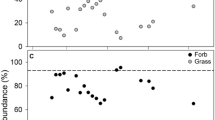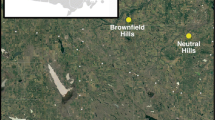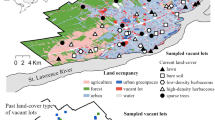Abstract
Spontaneous plant communities found in abandoned post-industrial landscapes develop in unique conditions which can create novel community assemblages. We examined changes in plant community composition and its relation to soil properties in an urban brownfield more than 40 years following site abandonment to better understand the community’s long-term trajectory. A former railyard and industrial area built on fill material, the study site includes four primary habitat types: grasslands, perennial forb assemblages, shrubland, and early successional forest. Plant species cover was measured in permanent plots in 2008 and 2016/17. In 2008, soil samples were collected and analyzed for a suite of properties. Species richness and Shannon diversity increased across the site from 2008 to 2016 (40 and 48 years post-abandonment) though increases in these parameters were highest in plots with lower metal concentrations. Evenness changed little in this time period. Percent cover of woody species increased in grassland and forb plots while percent cover of vines increased across all habitat types. Forb species tended to be associated with higher nutrient concentrations while woody species distribution was correlated with higher concentrations of heavy metals. The mitigation of soil stress, limitations in propagule availability, and loss of tree canopy cover following disturbances may have all played a role in influencing increases in diversity in this time period. Considering difficulties in comparing post-industrial abandoned landscapes to other anthropogenic and natural habitats, long-term study is needed to refine our understanding of community assembly in urban brownfields and better guide management practices.







Similar content being viewed by others
References
Anderson K (1989) Plants of liberty State Park, New Jersey. Bartonia 55:47–52
Anderson MJ (2001) A new method for non parametric multivariate analysis of variance. Austral Ecol 26:32–46. https://doi.org/10.1111/j.1442-9993.2001.01070.pp.x
Anderson KJ (2007) Temporal patterns in rates of community change during succession. Am Nat 169:780–793. https://doi.org/10.1086/516653
Aronson MFJ, Handel SN, La Puma IP, Clemants SE (2015) Urbanization promotes non-native woody species and diverse plant assemblages in the New York metropolitan region. Urban Ecosyst 18:31–45. https://doi.org/10.1007/s11252-014-0382-z
Bolan N, Kunhikrishnan A, Thangarajan R, Kumpiene J, Park J, Makino T, Kirkham MB, Scheckel K (2014) Remediation of heavy metal(loid)s contaminated soils – to mobilize or to immobilize? J Hazard Mater 266:141–166. https://doi.org/10.1016/j.jhazmat.2013.12.018
Bonthoux S, Brun M, Di Pietro F et al (2014) How can wastelands promote biodiversity in cities? A review. Landsc Urban Plan 132:79–88. https://doi.org/10.1016/j.landurbplan.2014.08.010
Brooks RT (2003) Abundance, distribution, trends, and ownership patterns of early-successional forests in the northeastern United States. For Ecol Manag 185:65–74. https://doi.org/10.1016/S0378-1127(03)00246-9
Brown A (1878) Plants introduced with ballast and on made land. Bull Torrety Bot Club 6:255–258
Brown S, Chaney RL, Hallfrisch JG, Xue Q (2000) Effect of biosolids processing on lead bioavailability in an urban soil. J Environ Qual 32:100–108. https://doi.org/10.2134/jeq2003.1000
Christensen NL (2014) An historical perspective on forest succession and its relevance to ecosystem restoration and conservation practice in North America. For Ecol Manag 330:312–322. https://doi.org/10.1016/j.foreco.2014.07.026
Colwell RK, Coddington JA (1994) Estimating terrestrial biodiversity through extrapolation. Philos Trans R Soc B Biol Sci 345:101–118. https://doi.org/10.1098/rstb.1994.0091
Concepción ED, Moretti M, Altermatt F, Nobis MP, Obrist MK (2015) Impacts of urbanisation on biodiversity: the role of species mobility, degree of specialisation and spatial scale. Oikos 124:1571–1582. https://doi.org/10.1111/oik.02166
Cramer VA, Hobbs RJ, Standish RJ (2008) What’s new about old fields? Land abandonment and ecosystem assembly. Trends Ecol Evol 23:104–112. https://doi.org/10.1016/j.tree.2007.10.005
Del Moral R, Saura JM, Emenegger JN (2010) Primary succession trajectories on a barren plain, Mount St. Helens, Washington. J Veg Sci 21:857–867. https://doi.org/10.1111/j.1654-1103.2010.01189.x
Del Tredici P (2010) Spontaneous urban vegetation: reflections of change in a globalized world. Nat Cult 5:299–315. https://doi.org/10.3167/nc.2010.050305
Dickinson NM, Turner AP, Lepp NW (1991) How do trees and other long-lived plants survive in polluted environments? Funct Ecol 5:5–11
Efroymson RA, Will ME, Suter GW II, Wooten AC (1997) Toxicological benchmarks for screening contaminants of potential concern for effects on terrestrial plants: 1997 revision. Oak Ridge, TN
Evans JM, Parker A, Gallagher F, Krumins JA (2015) Plant productivity, Ectomycorrhizae, and metal contamination in urban brownfield soils. Soil Sci 180:198–206. https://doi.org/10.1097/SS.0000000000000128
Freedman B, Hutchinson TC (1980) Long-term effects of smelter pollution at Sudbury, Ontario, on forest community composition. Can J Bot 58:2123–2140
Gallagher FJ, Pechmann I, Bogden JD, Grabosky J, Weis P (2008) Soil metal concentrations and vegetative assemblage structure in an urban brownfield. Environ Pollut 153:351–361. https://doi.org/10.1016/j.envpol.2007.08.011
Gallagher FJ, Pechmann I, Holzapfel C, Grabosky J (2011) Altered vegetative assemblage trajectories within an urban brownfield. Environ Pollut 159:1159–1166. https://doi.org/10.1016/j.envpol.2011.02.007
Gallagher FJ, Goodey NM, Singh JP et al (2018) Urban re-greening: a case study in multi-trophic biodiversity and ecosystem functioning in a post-industrial landscape. Diversity 10:119. https://doi.org/10.3390/d10040119
Gleason HA, Cronquist A (1991) Manual of vascular plants of northeastern United States and adjacent Canada, 2nd edn. NYBG Press, New York
Helldin J-O, Wissman J, Lennartsson T (2015) Abundance of red-listed species in infrastructure habitats – “responsibility species” as a priority-setting tool for transportation agencies´ conservation action. Nat Conserv 11:143–158. https://doi.org/10.3897/natureconservation.11.4433
Hernández DL, Esch EH, Alster CJ, McKone MJ, Camill P (2013) Rapid accumulation of soil carbon and nitrogen in a prairie restoration Chronosequence. Soil Sci Soc Am J 77:2029–2038. https://doi.org/10.2136/sssaj2012.0403
Hobbs RJ, Higgs E, Harris JA (2009) Novel ecosystems: implications for conservation and restoration. Trends Ecol Evol 24:599–605. https://doi.org/10.1016/j.tree.2009.05.012
Hofer C, Gallagher FJ, Holzapfel C (2010) Metal accumulation and performance of nestlings of passerine bird species at an urban brownfield site. Environ Pollut 158:1207–1213. https://doi.org/10.1016/j.envpol.2010.01.018
Hope ACA (1968) A simplified Monte Carlo significance test procedure. J R Stat Soc Ser B 30:582–598
Johnson LR, Handel SN (2016) Restoration treatments in urban park forests drive long-term changes in vegetation trajectories. Ecol Appl 26:940–956
Johnson AL, Tauzer EC, Swan CM (2015) Human legacies differentially organize functional and phylogenetic diversity of urban herbaceous plant communities at multiple spatial scales 18:513–527. https://doi.org/10.1111/avsc.12155
Johnson AL, Borowy D, Swan CM (2018) Land use history and seed dispersal drive divergent plant community assembly patterns in urban vacant lots. J Appl Ecol 55:451–460. https://doi.org/10.1111/1365-2664.12958
Jones CC, Del Moral R (2005) Patterns of primary succession on the foreland of Coleman glacier, Washington, USA. Plant Ecol 180:105–116. https://doi.org/10.1007/s11258-005-2843-1
King DI, Schlossberg S (2014) Synthesis of the conservation value of the early-successional stage in forests of eastern North America. For Ecol Manag 324:186–195. https://doi.org/10.1016/j.foreco.2013.12.001
Kompala-Baba A, Baba W (2013) The spontaneous succession in a sand-pit - the role of life history traits and species habitat preferences. Polish J Ecol 61:13–22
Kopel D, Malkinson D, Wittenberg L (2015) Characterization of vegetation community dynamics in areas affected by construction waste along the urban fringe. Urban Ecosyst 18:133–150. https://doi.org/10.1007/s11252-014-0396-6
Kowarik I (2011) Novel urban ecosystems, biodiversity, and conservation. Environ Pollut 159:1974–1983. https://doi.org/10.1016/j.envpol.2011.02.022
Krumins JA, Goodey NM, Gallagher F (2015) Plant–soil interactions in metal contaminated soils. Soil Biol Biochem 80:224–231. https://doi.org/10.1016/j.soilbio.2014.10.011
Leston LFV, Rodewald AD (2006) Are urban forests ecological traps for understory birds? An examination using northern cardinals. Biol Conserv 131:566–574. https://doi.org/10.1016/j.biocon.2006.03.003
Magurran AE (1988) Ecological diversity and its measurement. Princeton University Press, Princeton, NJ
Martinez-Fernandez C, Audirac I, Fol S, Cunningham-Sabot E (2012) Shrinking cities: urban challenges of globalization. Int J Urban Reg Res 36:213–225. https://doi.org/10.1111/j.1468-2427.2011.01092.x
Matthews ER, Schmit JP, Campbell JP (2016) Climbing vines and forest edges affect tree growth and mortality in temperate forests of the U.S. Mid-Atlantic States. For Ecol Manag 374:166–173. https://doi.org/10.1016/j.foreco.2016.05.005
Matthies SA, Rüter S, Schaarschmidt F, Prasse R (2017) Determinants of species richness within and across taxonomic groups in urban green spaces. Urban Ecosyst 20:897–909. https://doi.org/10.1007/s11252-017-0642-9
Myster RW, Pickett STA (1994) A comparison of rate of succession over 18 Yr in 10 contrasting old fields. Ecology 75:387–392. https://doi.org/10.2307/1939542
NECC (2011) Recommended soil testing procedures for the northeastern United States
New Jersey Department of Environmental Protection (NJDEP) (2016) List of endangered plant species and plant species of concern. Trenton, New Jersey
Oksanen J, Blanchet FG, Friendly M et al (2016) Vegan: community ecology package. R package version 2:4–1
Pielou EC (1966) The measurement of diversity in different types of biological collections. J Theor Biol 13:131–144. https://doi.org/10.1016/0022-5193(66)90013-0
Post WM, Kwon KC (2000) Soil carbon sequestration and land-use change: processes and potential. Glob Chang Biol 6:317–327. https://doi.org/10.1046/j.1365-2486.2000.00308.x
Prach K, Pysek P (2001) Using spontaneous succession for restoration of human-disturbed habitats: experience from Central Europe. Ecol Eng 17:55–62. https://doi.org/10.1016/S0925-8574(00)00132-4
Prach K, Řehounková K, Lencová K, Jírová A, Konvalinková P, Mudrák O, Študent V, Vaněček Z, Tichý L, Petřík P, Šmilauer P, Pyšek P (2014) Vegetation succession in restoration of disturbed sites in Central Europe: the direction of succession and species richness across 19 seres. Appl Veg Sci 17:193–200. https://doi.org/10.1111/avsc.12064
Rawlins BG, Vane CH, Kim AW, Tye AM, Kemp SJ, Bellamy PH (2008) Methods for estimating types of soil organic carbon and their application to surveys of UK urban areas. Soil Use Manag 24:47–59. https://doi.org/10.1111/j.1475-2743.2007.00132.x
Rebele F (1992) Colonization and early succession on anthropogenic soils. J Veg Sci 3:201–208. https://doi.org/10.2307/3235680
Řehounková K, Prach K (2008) Spontaneous vegetation succession in gravel-sand pits: a potential for restoration. Restor Ecol 16:305–312. https://doi.org/10.1111/j.1526-100X.2007.00316.x
Robinson SL, Lundholm JT (2012) Ecosystem services provided by urban spontaneous vegetation. Urban Ecosyst 15:545–557. https://doi.org/10.1007/s11252-012-0225-8
Rupprecht CDD, Byrne JA (2014) Informal urban greenspace: a typology and trilingual systematic review of its role for urban residents and trends in the literature. Urban For Urban Green 13:597–611. https://doi.org/10.1016/j.ufug.2014.09.002
Ruttens A, Colpaert JV, Mench M, Boisson J, Carleer R, Vangronsveld J (2006) Phytostabilization of a metal contaminated sandy soil. II: influence of compost and/or inorganic metal immobilizing soil amendments on metal leaching. Environ Pollut 144:533–539. https://doi.org/10.1016/j.envpol.2006.01.021
Salemaa M, Vanha-Majamaa I, Derome J (2001) Understorey vegetation along a heavy-metal pollution gradient in SW Finland. Environ Pollut 112:339–350. https://doi.org/10.1016/S0269-7491(00)00150-0
Salisbury AB (2017) Photosynthetic capacity along a gradient of trace element contamination in a spontaneous urban forest community. Rutgers, the State University of new Jersey
Salisbury AB, Reinfelder JR, Gallagher FJ, Grabosky JC (2017) Long-term stability of trace element concentrations in a spontaneously vegetated urban brownfield with anthropogenic soils. Soil Sci 182:69–81. https://doi.org/10.1097/SS.0000000000000193
Sanders PF (2003) Ambient levels of metals in New Jersey soils. Trenton, New Jersey
Schumann ME, White AS, Witham JW (2003) The effects of harvest-created gaps on plant species diversity, composition, and abundance in a Maine oak-pine forest. For Ecol Manag 176:543–561. https://doi.org/10.1016/S0378-1127(02)00233-5
Seto KC, Guneralp B, Hutyra LR (2012) Global forecasts of urban expansion to 2030 and direct impacts on biodiversity and carbon pools. Proc Natl Acad Sci 109:16083–16088. https://doi.org/10.1073/pnas.1211658109
Soil Survey Staff (2010) LadyLiberty soil series: primary characterization data
Sullivan J (1994) Platanus occidentalis. In: fire effects information system, [online]. U.S. Department of Agriculture, Forest Service, Rocky Mountain Research Station, fire sciences laboratory (producer)
Texas Instruments (1976) Liberty state park ecological study
Tirmenstein DA (1991a) Quercus rubra. In: fire effects information system, [online]. U.S. Department of Agriculture, Forest Service, Rocky Mountain Research Station, fire sciences laboratory (producer)
Tirmenstein DA (1991b) Acer rubrum. In: fire effects information system, [online]. U.S. Department of Agriculture, Forest Service, Rocky Mountain Research Station, fire sciences laboratory (producer)
Tropek R, Hejda M, Kadlec T, Spitzer L (2013) Local and landscape factors affecting communities of plants and diurnal Lepidoptera in black coal spoil heaps: implications for restoration management. Ecol Eng 57:252–260. https://doi.org/10.1016/j.ecoleng.2013.04.024
U.S. Army Corps of Engineers (2005) Hudson-Raritan Estuary, Liberty State park ecosystem restoraiton: Integrated Feasibility Report and Environmental Impact Statement Vol. 1. New York City, NY
United States Environmental Protection Agency (2003) Guidance for developing ecological soil screening levels. OSWER-Directive 9285
USDA, NRCS (2018) The PLANTS database. In: Natl. Plant Data Team, Greensboro, NC 27401–4901 USA. http://plants.usda.gov. Accessed 17 May 2018
Ussiri DAN, Lal R (2008) Method for determining coal carbon in the reclaimed Minesoils contaminated with coal. Soil Sci Soc Am J 72:231–237. https://doi.org/10.2136/sssaj2007.0047
Ward EB, Pregitzer CC, Kuebbing SE, Bradford MA (2020) Invasive lianas are drivers of and passengers to altered soil nutrient availability in urban forests. Biol Invasions 22:935–955. https://doi.org/10.1007/s10530-019-02134-2
Wickham H (2016) ggplot2: elegant graphics for data analysis. Springer-Verlag New York, New York
Woods AJ, Omernik JM, Moran BC (2007) Level III and IV Ecoregions of New Jersey. Corvallis, OR, USA
Zhang Y, Holzapfel C, Yuan X (2013) Scale dependent ecosystem service. In: Cullen R, Costanza R (eds) Ecosystem Services in Agricultural and Urban Landscapes. Wiley-Blackwell, Oxford, pp 107–121
Acknowledgments
We wish to thank the New Jersey Department of Environmental Protection Division of Parks and Forestry for continued access to the Liberty State Park Interior to conduct research. Thanks to Lenin Aldaz for assistance with data collection. AS contributed to investigation (field surveys), the formal data analysis and curation, writing original draft, reviewing and editing; FG contributed to reviewing and editing; HAP contributed to investigation (field surveys and plant identification) and editing; LMF contributed to investigation (field survey and soil analysis); and CH contributed to the project’s conceptualization, methodology, resources, project administration, investigation (field surveys), reviewing, editing and supervision.
Author information
Authors and Affiliations
Corresponding author
Appendices
Appendix 1
Appendix 2
Appendiix 3
Rights and permissions
About this article
Cite this article
Salisbury, A., Gallagher, F.J., Parag, H.A. et al. Plant diversity increases in an urban wildland after four decades of unaided vegetation development in a post-industrial site. Urban Ecosyst 24, 95–111 (2021). https://doi.org/10.1007/s11252-020-01018-x
Published:
Issue Date:
DOI: https://doi.org/10.1007/s11252-020-01018-x




